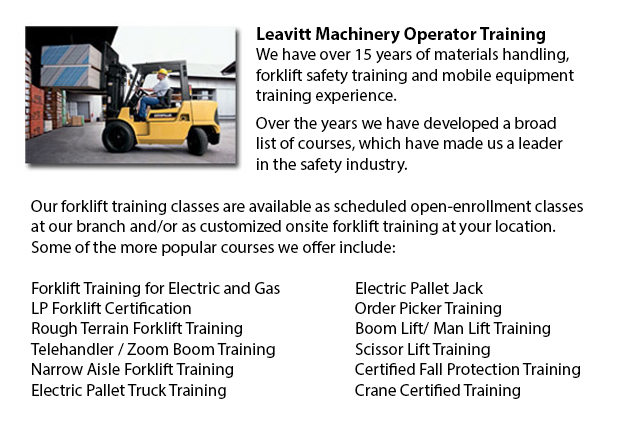
Rough Terrain Forklifts Training Whitby - There are in point of fact two classifications of lift trucks within the production business, the rough terrain model and the industrial model. Rough terrain forklifts appeared in the 1940's intended primarily for use on rough surfaces, ideal for lumberyards and construction sites, offering hauling muscle when there was no paved surface available.
Rough terrain lift trucks typically employ an internal combustion engine with a battery for power. The engines are able to function on propane, diesel or gas. Many suppliers are experimenting with rough land lift trucks that utilize vegetable matter and run from ethanol. Substantial pneumatic tires with deep treads typify these vehicles to allow them to clutch onto the roughest ground type without any slippage or sliding.
A few of the earliest designs of rough ground lift trucks had the ability to haul in excess of 1000 lbs, via blades that could slide underneath the item, haul it slightly and move it to an alternate location. After more than ten years on the market, rough terrain forklifts were reinforced with added hauling power, increasing the potential cargo to more than 2000 lbs. In the 1960's telescoping booms were added, allowing them to stack materials much higher than in earlier years. The telescoping model feature is a staple of nearly all all terrain lift trucks today. Present styles are capable of managing well over 4000 lbs due to the constant enhancements through the years. Telescoping capability has additionally improved with some styles achieving a height of 35 feet. Worker safety has also become a focus with many rough terrain lift trucks now manufactured are equipped with an enclosed cab for the operator, as opposed to the older open air seating capacity.
The all terrain forklifts on the market these days both perform admirably on unpaved surfaces and paved floors. This style of rough terrain forklift is marketed for its' adaptability enabling the possibility for businesses to use one unit to transport materials from an outside working site into a warehouse.
-
Scissor Pallet Trucks
Scissor Pallet Truck Training Whitby - Scissor lift pallet vehicles are made to be able to rearrange and stack pallets with a built-in lifting apparatus that permits the pallets to be elevated. This apparatus is really effective for working in restri... More -
Hyster Forklift
Hyster Forklift Training Whitby - Hyster is known as a international leader in lift trucks. However, it started as a producer of lifting machines and winches. Most of its production was focused in the Pacific Northwest and dealt primarily with the... More -
Pallet Stackers
Pallet Stackers Training Whitby - A pallet stacker is a kind of pallet jack that is utilized to transfer, stack and haul palletized produce that are overly difficult for manual lifting. Its key function is to load and unload pallets on vehicles, in a... More -
Komatsu Forklift
Komatsu Forklift Training Whitby - Komatsu Forklift U.S.A. Inc., an affiliate of the Komatsu Ltd. family, has an encouraging reputation for building robust and dependable lift trucks. They are renowned worldwide as a company who has a proud heritage... More -
Terex Forklift
Terex Forklift Forklift Training - Terex Forklifts stands by their mission to deliver a reliable and cost efficient product line. They take pleasure in manufacturing equipment that improves their consumers' earnings. Through many divestures and acqui... More

Forklift Training Whitby
TOLL FREE: 1-888-254-6157
Whitby, Ontario
forklifttrainingwhitby.com
Email Us
About Us


